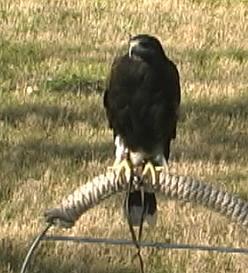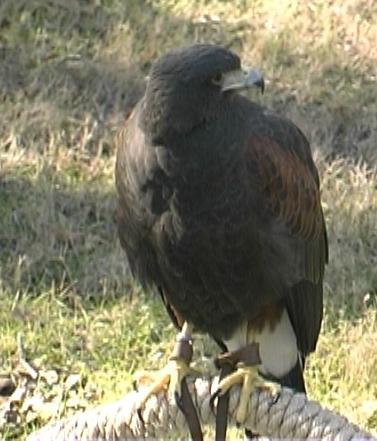Physical Description:
Medium size: about 18 inches. Weight is about 565-2000 g. Long tail and broad wings. Its color is dark brown with sienna shoulders, underwings and thighs.White feathers under the tail. (Grossman, Hamlet 281).
Special Adaptations:
Exhibits the most sophisticated cooperative hunting tactics documented in birds, involving up to six individuals. Members of the group will take turns flushing and chasing the prey until it is captured. (Ellis et al. 1993). On the ground, the hawk may spread its wings over the captured prey ("mantling"). Click here for a photo of this behavior. They have large eyes with sharp vision, but the eyes have a limited range of motion, so the hawk must move its head to keep prey in view.
Social Organization::
Pairs or polyandric family groups. The additional males help with raising young. The male is about a third smaller than the female and is sometimes called the tiercel.

Harris Tiercel: Photo courtesy of Cathy Hughes

Page Author:
Adi Arslanagic adi83sa@hotmail.com
WhoZoo Contact: mac@whozoo.org
Sources and Links:
- The Audubon Society Encyclopedia of North American Birds. by John K. Terres Alfred. A Knopf N.Y. 1980 pg. 508
- Birds of Prey of the World by M. L. Grossman, and J. Hamlet 1964 Clarkson N. Potter Inc. pg. 281
- Ellis, D.H., J.C. Bednarz, D.G. Smith, and S.P. Fleming. 1993. Social foraging classes in raptorial birds. Bioscience 43:14-20
- Walton, B., J Linthicum, and G. Stewart. 1988. Release and reestablishment techniques developed for Harris' hawks-Colorado River 1979-1986. Pages 318-320 in R.L. Glinski et al. (eds.). Proceedings of the southwest raptor management symposium and workshop. National Wildlife Federation, Washington, D.C.
- Desert Ecology: Harris Hawk Species Account:
http://helios.bto.ed.ac.uk/bto/desbiome/harris.htm
